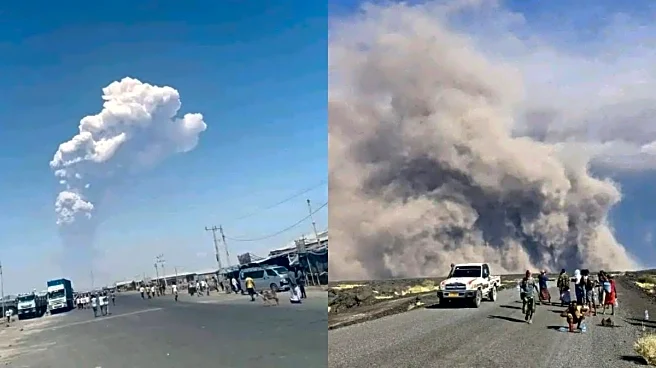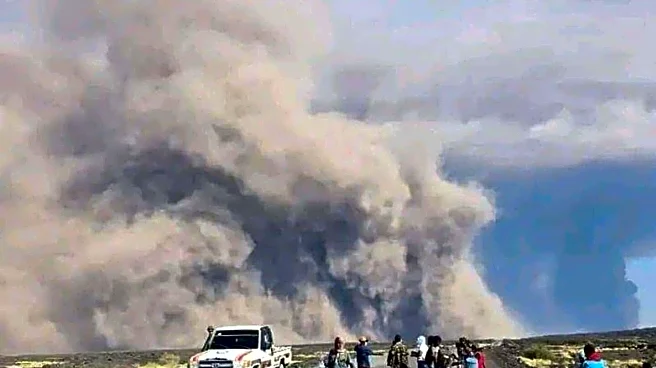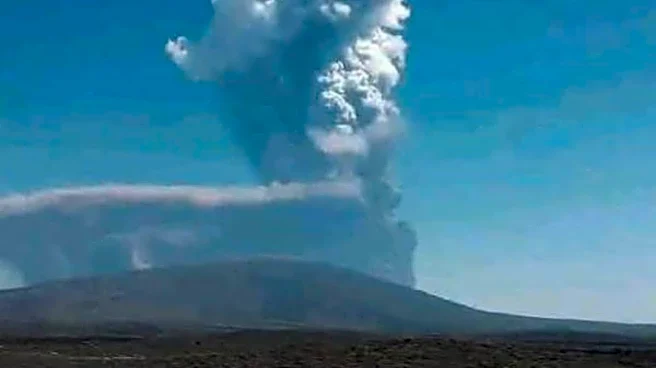Ethiopia’s Hayli Gubbi volcano, dormant for over 12,000 years, has erupted for the first time in recorded history. The impact of the eruption is said to be such that a plume of ash rose 10–15 km into the sky.
Volcanic ash from the volcano is drifting towards India and had started to enter parts of western and northern India, according to latest reports. The development has prompted airlines and airport authorities to issue precautionary notices to passengers.
The latest forecast says the volcanic ash cloud has been detected over North India, and was moving towards China as per the latest satellite imagery. It said the cloud is likely to clear India by 7:30 pm today.
Akasa Air, IndiGo, Air India and KLM are among the airlines that cancelled some flights due to the ash plumes on Tuesday.
Mumbai’s Chhatrapati Shivaji Maharaj International Airport issued a passenger advisory stating that volcanic activity in Ethiopia has affected parts of West Asian airspace and may impact certain international routes.
What is the Hayli Gubbi Volcano?
The Hayli Gubbi is a remote shield volcano in the Afar Region of Ethiopia, forming the southernmost part of the Erta Ale volcanic range. It sits at an elevation of about 493 metres above sea level.
Though the region is geologically active, Hayli Gubbi showed no confirmed eruptions during the Holocene (past 10,000–12,000 years) — until recently. On November 23, 2025, it produced a powerful explosive eruption, sending an ash plume as high as 13–15 km (around 45,000 ft) and releasing large quantities of sulfur dioxide.
Because the area is so remote and inhospitable, the eruption was primarily detected via satellite observations. The ash cloud from this event has posed risks to aviation and has drifted across the Red Sea into neighbouring regions – including Oman, Yemen, Iran, India and Pakistan.
How Did Hayli Gubbi Volcano Erupt?
The sudden eruption of the Hayli Gubbi volcano after thousands of years of dormancy is being said to have happened due to a combination of tectonic stretching, fresh magma intrusion, trapped gases, and a long-sealed system. This is best explained by the geological forces at work beneath the Afar region of Ethiopia. Hayli Gubbi sits within the Afar Rift, one of the few places on Earth where three tectonic plates — the African, Somali, and Arabian plates — are actively pulling apart. Over long periods, this rifting thins the crust, opens fractures, and creates deep pathways through which magma can slowly rise. Even a volcano that appears inactive on the surface can still have a warm, evolving magma system beneath it.
For years, magma likely accumulated beneath Hayli Gubbi without breaking through. The volcanic plumbing may have been sealed by hardened rock. As new magma intruded from deeper sources — possibly influenced by nearby activity in the Erta Ale volcanic system — pressure would have gradually built up. With time, the internal stress, heat, and gas content reached a point where the crustal seal could no longer hold.
When the eruption occurred, it was explosive, suggesting the magma was rich in dissolved gases like water vapour and sulfur dioxide. Gas-charged magma tends to fragment violently when it reaches the surface, producing tall ash columns like the one Hayli Gubbi emitted. Because the volcano had been quiet for so long, its upper system was likely cold and rigid, allowing pressure to accumulate more dramatically.
What’s Sending Ash Towards India?
When Hayli Gubbi erupted, it sent a massive ash plume up to 10–15 km into the atmosphere. At those heights, strong high-altitude winds carried the ash eastward, first across the Red Sea and then over the Arabian Peninsula.
These winds are part of the upper-level jet-stream-like flow, which can transport volcanic particles and sulfur dioxide for long distances without them quickly settling down.
By late Monday, meteorological services reported that the core of the ash cloud entered India via western Gujarat (around the Jodhpur–Jaisalmer region) and then moved into Rajasthan, north-west Maharashtra, Delhi, Haryana, and Punjab.
The plume was traveling fast — around 100–120 km/h — and at altitudes between 15,000 and 45,000 ft.
Aircraft are being affected: aviation authorities like the DGCA have issued advisories, and some flights are being cancelled or rerouted to avoid the ash-laden airspace.
The eruption’s high plume and favourable upper-level wind currents have carried ash from Ethiopia all the way into northwest and northern India.
Will This Ash Impact Air Quality In India?
There is likely to be no significant impact on air quality in Delhi due to the volcanic ash cloud, IMD DG Mrityunjay Mohapatra told CNN-News18.
According to reports, the ash coming from the volcano won’t lead to worsening of air quality in India since the plumes are higher. Reports say the ash clouds won’t impact surface level air quality even they there may be temporary haze or darkness.
Reports say any surface-level impact on air quality is likely to last only a few hours, as the plume continues to drift and weaken.


/images/ppid_a911dc6a-image-176404544047063153.webp)

/images/ppid_a911dc6a-image-176404286710753090.webp)


/images/ppid_a911dc6a-image-176404550095793340.webp)


/images/ppid_a911dc6a-image-176403763011891870.webp)


